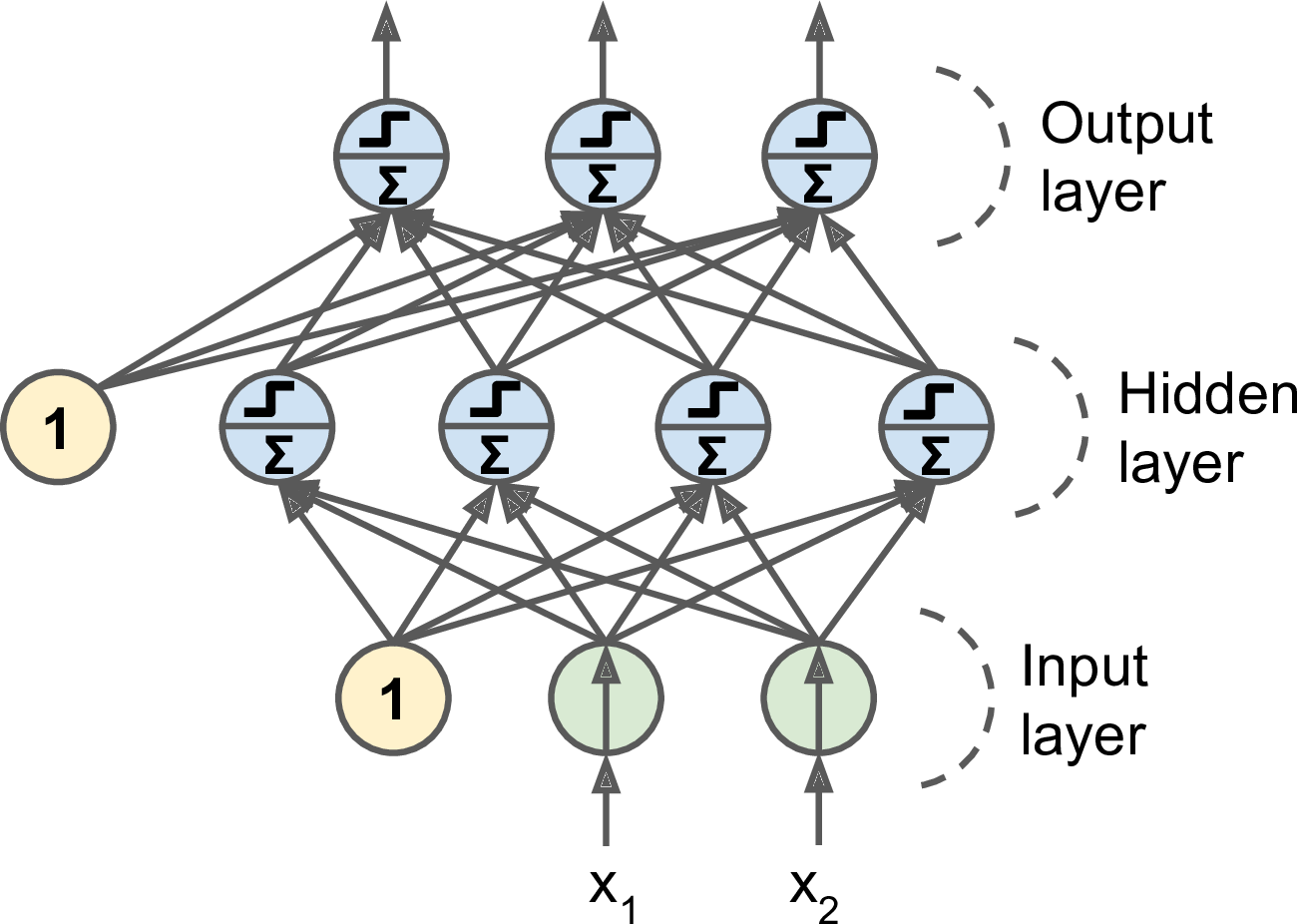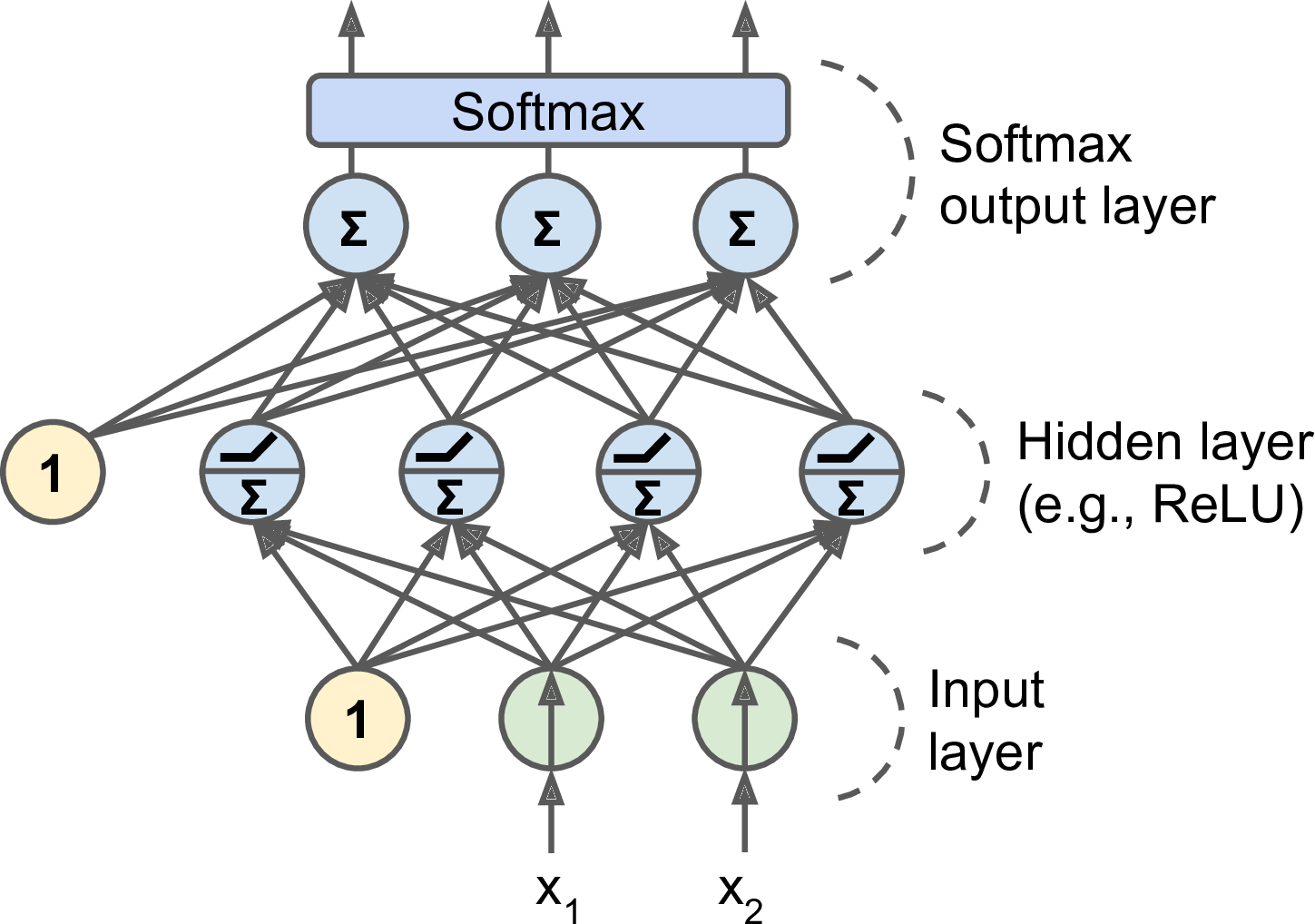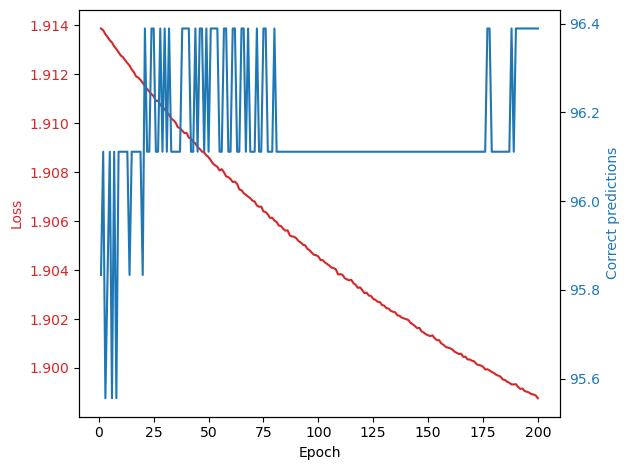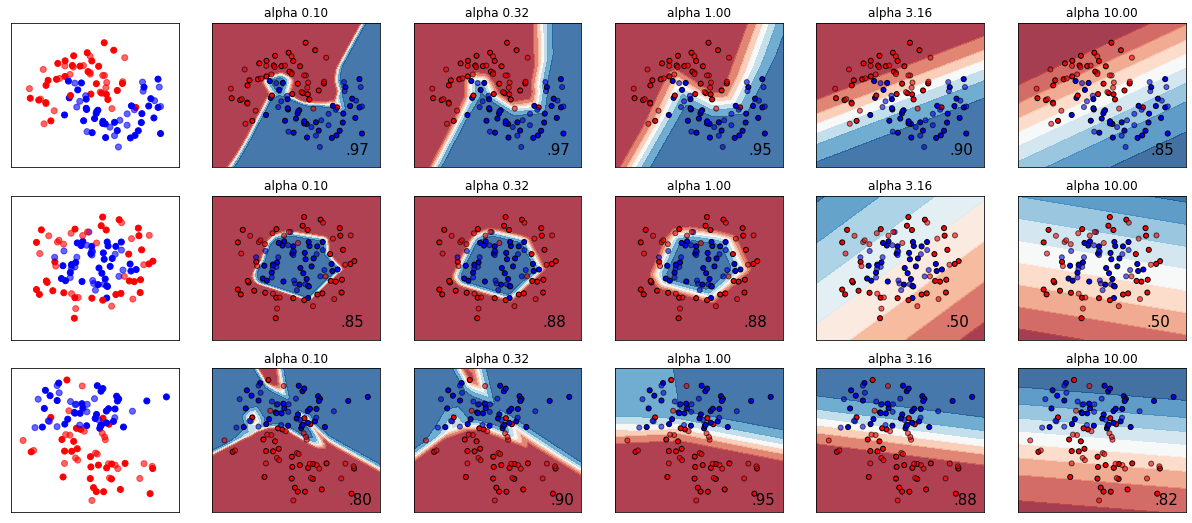4.2 Multi Layer Perceptrons
Contents
4.2 Multi Layer Perceptrons#
The linear model cannot fit all of the data. We can introduce nonlinearity by including hidden layers that connect each neuron with each other.
A MLP with a fully connected hidden layer. It has 4 inputs, 3 outputs, 5 hidden units.
MLPs can capture complex interactions among our inputs via their hidden neurons, which depend on the values of each of the inputs. We can model any function, so they are great universal approximators.
A fully connected or dense layer is one where all neurons are connected to all neurons from the previous layer. The output of a fully connected layer is: \(h(\mathbf{x}) = \phi (\mathbf{W} \mathbf{x} + \mathbf{b})\),
where \(\phi()\) is the activation function, \(\mathbf{b}\) is the bias vector, \(\mathbf{W}\) is the weight vectors, \(\mathbf{x}\) is the feature vector. Training a MLP is finding the weights and biases that best
1. Activation Functions#
Activation functions decide whether a neuron should be activated or not by calculating the weighted sum and further adding bias with it. We will review the activation functions:
Rectified linear unit (ReLU) ReLU provides a very simple nonlinear transformation. \(ReLU(x)=max(x,0).\) The reason for using ReLU is that its derivatives are particularly well behaved: either they vanish or they just let the argument through. This makes optimization better behaved. These are the most popular activation functions, easier to implement and to train.
Sigmoid Function The sigmoid function transforms its inputs, for which values lie in the real domain, to outputs that lie on the interval (0, 1). \(\sigma(x) = \frac{1}{1+\exp(-x)}\) The sigmoid function is a smooth, “S-shaped”, differentiable approximation to a thresholding unit. Sigmoids are still widely used as activation functions on the output units, when we want to interpret the outputs as probabilities for binary classification problems.
Tanh Function The hyperbolic tangent function is happy middle between the sigmoid and the ReLU as it is slightly more linear near zero. \(\tanh(x) = 2 \sigma(2x) -1\) Tanh is also “S-shaped”
import numpy as np
import matplotlib.pyplot as plt
%matplotlib inline
x=np.linspace(-2,2,100)
def sigm(x): # define the sigmoid function
return 1/(1+np.exp(-x))
def relu(x): # define the Rectified Linear Unit function
return np.maximum(x,0)
s = sigm(x)
t = np.tanh(x)
r = relu(x)
plt.plot(x,s)
plt.plot(x,r)
plt.plot(x,t)
plt.grid(True)
plt.legend(['sigmoid','ReLu','TanH'])
plt.xlim([-2,2])
plt.xlabel('X')
plt.title('activation functions')
Text(0.5, 1.0, 'activation functions')

2. Typical MLP structures#
A Regression MLP outputs scalar values, the number of output neurons is the number of values and the number of the output dimensions. For instance, to output a 2D geospatial coordinates on a map, you may need to output 2 values in 2 output neurons: latitudes and longitudes. For any real scalar as output values, the output layer is a normal layer of neurons. To constrain the value of the outputs, you can add an activation function in the output layer: use a ReLU or a softplus function for strictly positive values and a sigmoid or tanh activation function for bounded values between 0 (or -1) to 1 by scaling the output. A simple representation of a regression MLP is show in the first figure.

A Classification MLP outputs the probability of the positive class, a scalar value between 0 and 1. Use a ReLU or a softplus as an activation function in the output layer.

3. Training Neural Networks#
Training starts by handling a smaller batch of data inputs.
The forward pass sends the mini-batch from the input layer to the hidden layers. Forward propagation sequentially calculates and stores intermediate variables within the computational graph defined by the neural network. It proceeds from the input to the output layer and makes prediction.
Next, the algorithm measures the error using a loss function and calculate how much each of the output connection contributed to the error.
Backpropagation sequentially calculates and stores the gradients of intermediate variables and parameters within the neural network in the reversed order. Backpropagation is merely an application of chain rule to find the derivatives of cost with respect to any variable in the nested equation. The derivative of cost with respect to any weight in the network simply is the multiplication of the corresponding layer’s error times its input. Therefore in training, one has to save each layer input in addition to the weights, and therefore requires additional memory compared to a simple forward pass (prediction).
The algorithm then performs Gradient Descent to update the weights.
Drop out One additional mitigation against overfitting is to use dropout layers during training. During training, the Dropout layer will randomly drop out outputs of the previous layer (or equivalently, the inputs to the subsequent layer) according to the specified dropout probability. Dropout is only used during training.
a Sequential model is a single branch MLP.
4. MLP in Pytorch#
import torch
import torch.nn as nn
import torch.optim as optim
import matplotlib.pyplot as plt
import os
import numpy as np
4.1 Prepare Data#
# load data set in memory
from sklearn.datasets import load_digits
digits = load_digits() # load data set
data,labels = digits["data"].copy(),digits["target"].copy() # copy data and target
data = data.astype(np.float32).reshape(-1,8,8) # reshape data on 8x8 grid
print(data.shape,labels.shape)
(1797, 8, 8) (1797,)
Prepare the PyTorch-friendly data set:
Make
DatasetSplit train-test
Use
DataLoader
from torch.utils.data import Dataset, DataLoader
from torch.utils.data import random_split
class CustomDataset(Dataset): # create custom dataset
def __init__(self, data,labels): # initialize
self.data = data
self.labels = labels
def __len__(self):
return len(self.data)
def __getitem__(self, index):
sample_data = self.data[index]
sample_labels = self.labels[index]
return torch.Tensor(sample_data),(sample_labels) # return data as a tensor
custom_dataset = CustomDataset(data, labels)
# Determine the size of the training set
train_size = int(0.8 * len(custom_dataset)) # 80% of the data set
test_size = len(custom_dataset) - train_size # 20% of the data set
# Use random_split to create training and testing subsets
train_dataset, test_dataset = random_split(custom_dataset, [train_size, test_size])
# Create a DataLoader
batch_size = 32 # Adjust according to your needs
shuffle = True # Set to True if you want to shuffle the data
data_loader_train = DataLoader(train_dataset, batch_size=batch_size, shuffle=shuffle)
data_loader_test = DataLoader(test_dataset, batch_size=batch_size, shuffle=shuffle)
4.2 Design Model#
Set a random seeed for reproducibility
# Set fixed random number seed
torch.manual_seed(42)
<torch._C.Generator at 0x1e1e75e10>
Let’s create a Classification MLP for a multi-class problem. We use a flattened input layer to turn the 2D matrix into a 1D vector. The
# Fully connected MLP
class my_mlp(nn.Module): # a class defines an object
# this defines the architecture of the NN
def __init__(self, size_img, num_classes):
# Here we define all the functions that we will use during the forward part (data -> prediction)
super(my_mlp, self).__init__()
self.flatten = nn.Flatten() # go from a 8*8 tensor to a 64*1 tensor
self.layer1 = nn.Linear(size_img * size_img, 32)
self.relu1 = nn.ReLU()
self.layer2 = nn.Linear(32,16)
self.relu2 = nn.ReLU()
self.output_layer = nn.Linear(16,num_classes)
self.sigmoid = nn.Sigmoid()
# this defines how the data passes through the layers
def forward(self, x):
# Here we explain in which order to use the functions defined above
x = self.flatten(x)
x = self.relu1(self.layer1(x))
x = self.layer2(x)
return self.sigmoid(x)
Below is the syntax if you use Keras/TensorFlow
# model = keras.models.Sequential( [
# keras.layers.Flatten(input_shape=[28,28]), # reshape the 2D matrix into a 1D vector, without modifying the values
# keras.layers.Dense(300,activation="relu"), # single dense layer, downsampling from input layer to this year from 784 points to 300.
# keras.layers.Dense(100,activation="relu"), # 100 neurons
# keras.layers.Dense(10,activation="softmax") ]) # output layer, 10 neurons since there are 10 classes.
model = my_mlp(8, 10)
print(model)
my_mlp(
(flatten): Flatten(start_dim=1, end_dim=-1)
(layer1): Linear(in_features=64, out_features=32, bias=True)
(relu1): ReLU()
(layer2): Linear(in_features=32, out_features=16, bias=True)
(relu2): ReLU()
(output_layer): Linear(in_features=16, out_features=10, bias=True)
(sigmoid): Sigmoid()
)
4.3 Optimization#
Choose an optimizer to train the algorithm: https://pytorch.org/docs/stable/optim.html. Choose hyperparameters.
alpha = 0.005# learning rate lr
loss_function = nn.CrossEntropyLoss()
optimizer = torch.optim.Adam(model.parameters(), lr=alpha)
4.4 Training#
Compile the model by setting the loss function, the optimizer to use, and the metrics to use during training and evaluation
During the fitting, it may be important to save intermediate steps and maybe revert back to an earlier version of the training. For this, we will use checkpoints to save the model at regular intervals during the training.
def train(model, n_epochs, trainloader, testloader=None,learning_rate=0.001 ):
dir0 = './my_mlp_checkpoint'
os.makedirs(dir0,exist_ok=True)
criterion = nn.CrossEntropyLoss() # loss function
optimizer = optim.SGD(model.parameters(), lr=learning_rate) # optimizer
# Save loss and error for plotting
loss_time = np.zeros(n_epochs)
accuracy_time = np.zeros(n_epochs)
# TRAIN Loop on number of epochs
for epoch in range(n_epochs):
# Initialize the loss
running_loss = 0
# Loop on samples in train set
for data in trainloader:
# Get the sample and modify the format for PyTorch
inputs, labels = data[0], data[1]
inputs = inputs.float()
labels = labels.long()
# Set the parameter gradients to zero
optimizer.zero_grad()
outputs = model(inputs) # forward pass
loss = criterion(outputs, labels) # compute loss
loss.backward() # backward pass
optimizer.step() # update weights
running_loss += loss.item() # sumup loss
# Save loss at the end of each epoch
loss_time[epoch] = running_loss/len(trainloader)
# note that here the loss is the average loss per sample over the batch
checkpoint = {
'epoch': epoch + 1,
'state_dict': model.state_dict(),
'optimizer': optimizer.state_dict()
}
f_path = dir0+'/checkpoint.pt'
torch.save(checkpoint, f_path)
# TEST: After each epoch, evaluate the performance on the test set
if testloader is not None:
correct = 0
total = 0
# We evaluate the model, so we do not need the gradient
with torch.no_grad(): # Context-manager that disabled gradient calculation.
# Loop on samples in test set
for data in testloader:
# Get the sample and modify the format for PyTorch
inputs, labels = data[0], data[1]
inputs = inputs.float()
labels = labels.long()
# Use model for sample in the test set
outputs = model(inputs)
# Compare predicted label and true label
_, predicted = torch.max(outputs.data, 1)
total += labels.size(0)
correct += (predicted == labels).sum().item()
# Save error at the end of each epochs
accuracy_time[epoch] = 100 * correct / total
# Print intermediate results on screen
if testloader is not None:
print('[Epoch %d] loss: %.3f - accuracy: %.3f' %
(epoch + 1, running_loss/len(trainloader), 100 * correct / total))
else:
print('[Epoch %d] loss: %.3f' %
(epoch + 1, running_loss/len(trainloader)))
# Save history of loss and test error
if testloader is not None:
return (loss_time, accuracy_time)
else:
return (loss_time)
Train the model
(loss, accuracy) = train(model, 200, data_loader_train, data_loader_test, alpha)
[Epoch 1] loss: 1.914 - accuracy: 95.833
[Epoch 2] loss: 1.914 - accuracy: 96.111
[Epoch 3] loss: 1.914 - accuracy: 95.556
[Epoch 4] loss: 1.914 - accuracy: 95.833
[Epoch 5] loss: 1.913 - accuracy: 96.111
[Epoch 6] loss: 1.913 - accuracy: 95.556
[Epoch 7] loss: 1.913 - accuracy: 96.111
[Epoch 8] loss: 1.913 - accuracy: 95.556
[Epoch 9] loss: 1.913 - accuracy: 96.111
[Epoch 10] loss: 1.913 - accuracy: 96.111
[Epoch 11] loss: 1.913 - accuracy: 96.111
[Epoch 12] loss: 1.913 - accuracy: 96.111
[Epoch 13] loss: 1.912 - accuracy: 96.111
[Epoch 14] loss: 1.912 - accuracy: 95.833
[Epoch 15] loss: 1.912 - accuracy: 96.111
[Epoch 16] loss: 1.912 - accuracy: 96.111
[Epoch 17] loss: 1.912 - accuracy: 96.111
[Epoch 18] loss: 1.912 - accuracy: 96.111
[Epoch 19] loss: 1.912 - accuracy: 96.111
[Epoch 20] loss: 1.912 - accuracy: 95.833
[Epoch 21] loss: 1.912 - accuracy: 96.389
[Epoch 22] loss: 1.911 - accuracy: 96.111
[Epoch 23] loss: 1.911 - accuracy: 96.111
[Epoch 24] loss: 1.911 - accuracy: 96.389
[Epoch 25] loss: 1.911 - accuracy: 96.389
[Epoch 26] loss: 1.911 - accuracy: 96.111
[Epoch 27] loss: 1.911 - accuracy: 96.111
[Epoch 28] loss: 1.911 - accuracy: 96.389
[Epoch 29] loss: 1.911 - accuracy: 96.111
[Epoch 30] loss: 1.911 - accuracy: 96.389
[Epoch 31] loss: 1.910 - accuracy: 96.111
[Epoch 32] loss: 1.910 - accuracy: 96.389
[Epoch 33] loss: 1.910 - accuracy: 96.111
[Epoch 34] loss: 1.910 - accuracy: 96.111
[Epoch 35] loss: 1.910 - accuracy: 96.111
[Epoch 36] loss: 1.910 - accuracy: 96.111
[Epoch 37] loss: 1.910 - accuracy: 96.111
[Epoch 38] loss: 1.910 - accuracy: 96.389
[Epoch 39] loss: 1.910 - accuracy: 96.389
[Epoch 40] loss: 1.910 - accuracy: 96.389
[Epoch 41] loss: 1.909 - accuracy: 96.389
[Epoch 42] loss: 1.909 - accuracy: 96.111
[Epoch 43] loss: 1.909 - accuracy: 96.111
[Epoch 44] loss: 1.909 - accuracy: 96.389
[Epoch 45] loss: 1.909 - accuracy: 96.111
[Epoch 46] loss: 1.909 - accuracy: 96.389
[Epoch 47] loss: 1.909 - accuracy: 96.389
[Epoch 48] loss: 1.909 - accuracy: 96.111
[Epoch 49] loss: 1.909 - accuracy: 96.389
[Epoch 50] loss: 1.909 - accuracy: 96.111
[Epoch 51] loss: 1.908 - accuracy: 96.389
[Epoch 52] loss: 1.908 - accuracy: 96.389
[Epoch 53] loss: 1.908 - accuracy: 96.389
[Epoch 54] loss: 1.908 - accuracy: 96.389
[Epoch 55] loss: 1.908 - accuracy: 96.111
[Epoch 56] loss: 1.908 - accuracy: 96.111
[Epoch 57] loss: 1.908 - accuracy: 96.389
[Epoch 58] loss: 1.908 - accuracy: 96.389
[Epoch 59] loss: 1.908 - accuracy: 96.111
[Epoch 60] loss: 1.908 - accuracy: 96.111
[Epoch 61] loss: 1.908 - accuracy: 96.389
[Epoch 62] loss: 1.908 - accuracy: 96.389
[Epoch 63] loss: 1.908 - accuracy: 96.111
[Epoch 64] loss: 1.907 - accuracy: 96.111
[Epoch 65] loss: 1.907 - accuracy: 96.389
[Epoch 66] loss: 1.907 - accuracy: 96.389
[Epoch 67] loss: 1.907 - accuracy: 96.111
[Epoch 68] loss: 1.907 - accuracy: 96.389
[Epoch 69] loss: 1.907 - accuracy: 96.111
[Epoch 70] loss: 1.907 - accuracy: 96.111
[Epoch 71] loss: 1.907 - accuracy: 96.111
[Epoch 72] loss: 1.907 - accuracy: 96.389
[Epoch 73] loss: 1.907 - accuracy: 96.111
[Epoch 74] loss: 1.907 - accuracy: 96.111
[Epoch 75] loss: 1.906 - accuracy: 96.389
[Epoch 76] loss: 1.906 - accuracy: 96.389
[Epoch 77] loss: 1.906 - accuracy: 96.111
[Epoch 78] loss: 1.906 - accuracy: 96.111
[Epoch 79] loss: 1.906 - accuracy: 96.111
[Epoch 80] loss: 1.906 - accuracy: 96.389
[Epoch 81] loss: 1.906 - accuracy: 96.111
[Epoch 82] loss: 1.906 - accuracy: 96.111
[Epoch 83] loss: 1.906 - accuracy: 96.111
[Epoch 84] loss: 1.906 - accuracy: 96.111
[Epoch 85] loss: 1.906 - accuracy: 96.111
[Epoch 86] loss: 1.906 - accuracy: 96.111
[Epoch 87] loss: 1.905 - accuracy: 96.111
[Epoch 88] loss: 1.905 - accuracy: 96.111
[Epoch 89] loss: 1.905 - accuracy: 96.111
[Epoch 90] loss: 1.905 - accuracy: 96.111
[Epoch 91] loss: 1.905 - accuracy: 96.111
[Epoch 92] loss: 1.905 - accuracy: 96.111
[Epoch 93] loss: 1.905 - accuracy: 96.111
[Epoch 94] loss: 1.905 - accuracy: 96.111
[Epoch 95] loss: 1.905 - accuracy: 96.111
[Epoch 96] loss: 1.905 - accuracy: 96.111
[Epoch 97] loss: 1.905 - accuracy: 96.111
[Epoch 98] loss: 1.905 - accuracy: 96.111
[Epoch 99] loss: 1.905 - accuracy: 96.111
[Epoch 100] loss: 1.905 - accuracy: 96.111
[Epoch 101] loss: 1.904 - accuracy: 96.111
[Epoch 102] loss: 1.904 - accuracy: 96.111
[Epoch 103] loss: 1.904 - accuracy: 96.111
[Epoch 104] loss: 1.904 - accuracy: 96.111
[Epoch 105] loss: 1.904 - accuracy: 96.111
[Epoch 106] loss: 1.904 - accuracy: 96.111
[Epoch 107] loss: 1.904 - accuracy: 96.111
[Epoch 108] loss: 1.904 - accuracy: 96.111
[Epoch 109] loss: 1.904 - accuracy: 96.111
[Epoch 110] loss: 1.904 - accuracy: 96.111
[Epoch 111] loss: 1.904 - accuracy: 96.111
[Epoch 112] loss: 1.904 - accuracy: 96.111
[Epoch 113] loss: 1.904 - accuracy: 96.111
[Epoch 114] loss: 1.904 - accuracy: 96.111
[Epoch 115] loss: 1.904 - accuracy: 96.111
[Epoch 116] loss: 1.903 - accuracy: 96.111
[Epoch 117] loss: 1.903 - accuracy: 96.111
[Epoch 118] loss: 1.903 - accuracy: 96.111
[Epoch 119] loss: 1.903 - accuracy: 96.111
[Epoch 120] loss: 1.903 - accuracy: 96.111
[Epoch 121] loss: 1.903 - accuracy: 96.111
[Epoch 122] loss: 1.903 - accuracy: 96.111
[Epoch 123] loss: 1.903 - accuracy: 96.111
[Epoch 124] loss: 1.903 - accuracy: 96.111
[Epoch 125] loss: 1.903 - accuracy: 96.111
[Epoch 126] loss: 1.903 - accuracy: 96.111
[Epoch 127] loss: 1.903 - accuracy: 96.111
[Epoch 128] loss: 1.903 - accuracy: 96.111
[Epoch 129] loss: 1.903 - accuracy: 96.111
[Epoch 130] loss: 1.903 - accuracy: 96.111
[Epoch 131] loss: 1.902 - accuracy: 96.111
[Epoch 132] loss: 1.902 - accuracy: 96.111
[Epoch 133] loss: 1.902 - accuracy: 96.111
[Epoch 134] loss: 1.902 - accuracy: 96.111
[Epoch 135] loss: 1.902 - accuracy: 96.111
[Epoch 136] loss: 1.902 - accuracy: 96.111
[Epoch 137] loss: 1.902 - accuracy: 96.111
[Epoch 138] loss: 1.902 - accuracy: 96.111
[Epoch 139] loss: 1.902 - accuracy: 96.111
[Epoch 140] loss: 1.902 - accuracy: 96.111
[Epoch 141] loss: 1.902 - accuracy: 96.111
[Epoch 142] loss: 1.902 - accuracy: 96.111
[Epoch 143] loss: 1.902 - accuracy: 96.111
[Epoch 144] loss: 1.902 - accuracy: 96.111
[Epoch 145] loss: 1.902 - accuracy: 96.111
[Epoch 146] loss: 1.902 - accuracy: 96.111
[Epoch 147] loss: 1.901 - accuracy: 96.111
[Epoch 148] loss: 1.901 - accuracy: 96.111
[Epoch 149] loss: 1.901 - accuracy: 96.111
[Epoch 150] loss: 1.901 - accuracy: 96.111
[Epoch 151] loss: 1.901 - accuracy: 96.111
[Epoch 152] loss: 1.901 - accuracy: 96.111
[Epoch 153] loss: 1.901 - accuracy: 96.111
[Epoch 154] loss: 1.901 - accuracy: 96.111
[Epoch 155] loss: 1.901 - accuracy: 96.111
[Epoch 156] loss: 1.901 - accuracy: 96.111
[Epoch 157] loss: 1.901 - accuracy: 96.111
[Epoch 158] loss: 1.901 - accuracy: 96.111
[Epoch 159] loss: 1.901 - accuracy: 96.111
[Epoch 160] loss: 1.901 - accuracy: 96.111
[Epoch 161] loss: 1.901 - accuracy: 96.111
[Epoch 162] loss: 1.901 - accuracy: 96.111
[Epoch 163] loss: 1.901 - accuracy: 96.111
[Epoch 164] loss: 1.901 - accuracy: 96.111
[Epoch 165] loss: 1.901 - accuracy: 96.111
[Epoch 166] loss: 1.900 - accuracy: 96.111
[Epoch 167] loss: 1.900 - accuracy: 96.111
[Epoch 168] loss: 1.900 - accuracy: 96.111
[Epoch 169] loss: 1.900 - accuracy: 96.111
[Epoch 170] loss: 1.900 - accuracy: 96.111
[Epoch 171] loss: 1.900 - accuracy: 96.111
[Epoch 172] loss: 1.900 - accuracy: 96.111
[Epoch 173] loss: 1.900 - accuracy: 96.111
[Epoch 174] loss: 1.900 - accuracy: 96.111
[Epoch 175] loss: 1.900 - accuracy: 96.111
[Epoch 176] loss: 1.900 - accuracy: 96.111
[Epoch 177] loss: 1.900 - accuracy: 96.389
[Epoch 178] loss: 1.900 - accuracy: 96.389
[Epoch 179] loss: 1.900 - accuracy: 96.111
[Epoch 180] loss: 1.900 - accuracy: 96.111
[Epoch 181] loss: 1.900 - accuracy: 96.111
[Epoch 182] loss: 1.900 - accuracy: 96.111
[Epoch 183] loss: 1.900 - accuracy: 96.111
[Epoch 184] loss: 1.900 - accuracy: 96.111
[Epoch 185] loss: 1.900 - accuracy: 96.111
[Epoch 186] loss: 1.899 - accuracy: 96.111
[Epoch 187] loss: 1.899 - accuracy: 96.111
[Epoch 188] loss: 1.899 - accuracy: 96.389
[Epoch 189] loss: 1.899 - accuracy: 96.111
[Epoch 190] loss: 1.899 - accuracy: 96.389
[Epoch 191] loss: 1.899 - accuracy: 96.389
[Epoch 192] loss: 1.899 - accuracy: 96.389
[Epoch 193] loss: 1.899 - accuracy: 96.389
[Epoch 194] loss: 1.899 - accuracy: 96.389
[Epoch 195] loss: 1.899 - accuracy: 96.389
[Epoch 196] loss: 1.899 - accuracy: 96.389
[Epoch 197] loss: 1.899 - accuracy: 96.389
[Epoch 198] loss: 1.899 - accuracy: 96.389
[Epoch 199] loss: 1.899 - accuracy: 96.389
[Epoch 200] loss: 1.899 - accuracy: 96.389
Plot the learning curve
fig, ax1 = plt.subplots()
color = 'tab:red'
ax1.set_xlabel('Epoch')
ax1.set_ylabel('Loss', color=color)
ax1.plot(np.arange(1, len(loss)+1), loss, color=color)
ax1.tick_params(axis='y', labelcolor=color)
ax2 = ax1.twinx()
color = 'tab:blue'
ax2.set_ylabel('Correct predictions', color=color)
ax2.plot(np.arange(1, len(accuracy)+1), accuracy, color=color)
ax2.tick_params(axis='y', labelcolor=color)
fig.tight_layout()
plt.show()

Report value on test set.
X_new = X_test[:2]
y_proba = model.predict(X_new).round(2)
print(y_proba)
---------------------------------------------------------------------------
NameError Traceback (most recent call last)
/Users/marinedenolle/Dropbox/CLASSES/ESS490/curriculum-book/book/Chapter4-DeepLearning/mlgeo_4.2_MultiLayerPerceptron.ipynb Cell 28 line 1
----> <a href='vscode-notebook-cell:/Users/marinedenolle/Dropbox/CLASSES/ESS490/curriculum-book/book/Chapter4-DeepLearning/mlgeo_4.2_MultiLayerPerceptron.ipynb#X41sZmlsZQ%3D%3D?line=0'>1</a> X_new = X_test[:2]
<a href='vscode-notebook-cell:/Users/marinedenolle/Dropbox/CLASSES/ESS490/curriculum-book/book/Chapter4-DeepLearning/mlgeo_4.2_MultiLayerPerceptron.ipynb#X41sZmlsZQ%3D%3D?line=1'>2</a> y_proba = model.predict(X_new).round(2)
<a href='vscode-notebook-cell:/Users/marinedenolle/Dropbox/CLASSES/ESS490/curriculum-book/book/Chapter4-DeepLearning/mlgeo_4.2_MultiLayerPerceptron.ipynb#X41sZmlsZQ%3D%3D?line=2'>3</a> print(y_proba)
NameError: name 'X_test' is not defined
4. Saving and restoring a model#
5. Fine-tuning of Neural Networks Hyperparameters#
Trial and error is a great first step to build some basic intuition around NN and their training. However, a more systematic approach is to search the hyper-parameter space using grid search or randomized searches. Scikit-learn has modules dedicated to this: https://scikit-learn.org/stable/modules/generated/sklearn.model_selection.RandomizedSearchCV.html
We will need to bundle our keras-built model into a function callable by scikit-learn. This is done using the KerasRegressor and KerasClassifer objects.
More on this later!
MLP with scikit learn#
There are some basic NN built in scikit learn, you can see below a tutorial. However, it is limited and one would use pytorch, keras, or tensorflow for any moderate to large model training. Here we will use a “sparse” categorical cross entropy. Cross entropy is used in multiclass classification. Categorical is because the classes are exclusive and that we have sparse labels (either 0 or 1).
# Below is an exampled of a classification MLP using Scikit learn.
import numpy as np
from matplotlib import pyplot as plt
from matplotlib.colors import ListedColormap
from sklearn.model_selection import train_test_split
from sklearn.preprocessing import StandardScaler
from sklearn.datasets import make_moons, make_circles, make_classification
from sklearn.neural_network import MLPClassifier
from sklearn.pipeline import make_pipeline
h = .02 # step size in the mesh
alphas = np.logspace(-1, 1, 5)
classifiers = []
names = []
for alpha in alphas:
classifiers.append(make_pipeline(
StandardScaler(),
MLPClassifier(
solver='lbfgs', alpha=alpha, random_state=1, max_iter=2000,
early_stopping=True, hidden_layer_sizes=[100, 100],
)
))
names.append(f"alpha {alpha:.2f}")
X, y = make_classification(n_features=2, n_redundant=0, n_informative=2,
random_state=0, n_clusters_per_class=1)
rng = np.random.RandomState(2)
X += 2 * rng.uniform(size=X.shape)
linearly_separable = (X, y)
datasets = [make_moons(noise=0.3, random_state=0),
make_circles(noise=0.2, factor=0.5, random_state=1),
linearly_separable]
figure = plt.figure(figsize=(17, 9))
i = 1
# iterate over datasets
for X, y in datasets:
# split into training and test part
X_train, X_test, y_train, y_test = train_test_split(X, y, test_size=.4)
x_min, x_max = X[:, 0].min() - .5, X[:, 0].max() + .5
y_min, y_max = X[:, 1].min() - .5, X[:, 1].max() + .5
xx, yy = np.meshgrid(np.arange(x_min, x_max, h),
np.arange(y_min, y_max, h))
# just plot the dataset first
cm = plt.cm.RdBu
cm_bright = ListedColormap(['#FF0000', '#0000FF'])
ax = plt.subplot(len(datasets), len(classifiers) + 1, i)
# Plot the training points
ax.scatter(X_train[:, 0], X_train[:, 1], c=y_train, cmap=cm_bright)
# and testing points
ax.scatter(X_test[:, 0], X_test[:, 1], c=y_test, cmap=cm_bright, alpha=0.6)
ax.set_xlim(xx.min(), xx.max())
ax.set_ylim(yy.min(), yy.max())
ax.set_xticks(())
ax.set_yticks(())
i += 1
# iterate over classifiers
for name, clf in zip(names, classifiers):
ax = plt.subplot(len(datasets), len(classifiers) + 1, i)
clf.fit(X_train, y_train)
score = clf.score(X_test, y_test)
# Plot the decision boundary. For that, we will assign a color to each
# point in the mesh [x_min, x_max] x [y_min, y_max].
if hasattr(clf, "decision_function"):
Z = clf.decision_function(np.c_[xx.ravel(), yy.ravel()])
else:
Z = clf.predict_proba(np.c_[xx.ravel(), yy.ravel()])[:, 1]
# Put the result into a color plot
Z = Z.reshape(xx.shape)
ax.contourf(xx, yy, Z, cmap=cm, alpha=.8)
# Plot also the training points
ax.scatter(X_train[:, 0], X_train[:, 1], c=y_train, cmap=cm_bright,
edgecolors='black', s=25)
# and testing points
ax.scatter(X_test[:, 0], X_test[:, 1], c=y_test, cmap=cm_bright,
alpha=0.6, edgecolors='black', s=25)
ax.set_xlim(xx.min(), xx.max())
ax.set_ylim(yy.min(), yy.max())
ax.set_xticks(())
ax.set_yticks(())
ax.set_title(name)
ax.text(xx.max() - .3, yy.min() + .3, ('%.2f' % score).lstrip('0'),
size=15, horizontalalignment='right')
i += 1
figure.subplots_adjust(left=.02, right=.98)
plt.show()

Forward Model with PyTorch#
Scikit-learn is usually referred for tree-based models (e.g., random forest, xgboost,). PyTorch and Tensorflow are more powerful regarding neural network type of models. Here is a simple example of PyTorch creating a model for this task.
import torch
import torch.nn as nn
import torch.nn.functional as F
class Net(nn.Module):
def __init__(self):
super(Net, self).__init__()
# 1 input image channel, 6 output channels, 5x5 square convolution
# kernel
self.conv1 = nn.Conv2d(1, 6, 5)
self.conv2 = nn.Conv2d(6, 16, 5)
# an affine operation: y = Wx + b
self.fc1 = nn.Linear(16 * 5 * 5, 120) # 5*5 from image dimension
self.fc2 = nn.Linear(120, 84)
self.fc3 = nn.Linear(84, 10)
def forward(self, x):
# Max pooling over a (2, 2) window
x = F.max_pool2d(F.relu(self.conv1(x)), (2, 2))
# If the size is a square, you can specify with a single number
x = F.max_pool2d(F.relu(self.conv2(x)), 2)
x = torch.flatten(x, 1) # flatten all dimensions except the batch dimension
x = F.relu(self.fc1(x))
x = F.relu(self.fc2(x))
x = self.fc3(x)
return x
net = Net()
print(net)
Failed to start the Kernel.
Kernel Python 3.9.6 is not usable. Check the Jupyter output tab for more information.
View Jupyter <a href='command:jupyter.viewOutput'>log</a> for further details.
